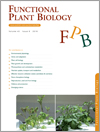
Functional Plant Biology
Volume 45 Number 6 2018
FP17303Integrated genomics, physiology and breeding approaches for improving nitrogen use efficiency in potato: translating knowledge from other crops
Potato is a high nitrogen-responsive crop, hence improving nitrogen use efficiency (NUE) of plant is important to reduce production cost and minimise environmental loss. Potato is a less studied crop especially at plant level with enhanced NUE. This review highlights translation of advanced NUE research from other plants like Arabidopsis, rice, wheat and maize applying integrated genomics, physiology and breeding approaches.
FP17266Improving nitrogen use efficiency in plants: effective phenotyping in conjunction with agronomic and genetic approaches
Nitrogen use efficiency (NUE) in most crops is low, resulting in N waste, leading to increased crop production costs and environmental concerns globally. Efficient and reliable phenotyping would help manage N application and speeding up efforts to breed crop varieties with higher NUE. A comprehensive insight is provided into the approaches, tools and methods applicable to phenotyping NUE-related traits in crops.
FP17162Antioxidant capacity along the leaf blade of the C3-CAM facultative bromeliad Guzmania monostachia under water deficit conditions
Guzmania monostachia is an epiphytic, tank-forming bromeliad that displays variable degrees of crassulacean acid metabolism (CAM) along the leaf blade under water deficit conditions. The hypothesis that the most intense CAM found in the apex portion is related to reduced oxidative burden was not confirmed. However, G. monostachia was able to keep reactive oxygen species under tolerable levels under water deficit conditions by increasing the antioxidant capacity in the apex, which is the leaf portion most exposed to light.
FP17249S-nitrosocysteine-responsive genes modulate diverse regulatory pathways in Oryza sativa: a transcriptome profiling study
One of the good news in plants is NO news. NO is an all-around molecule that plays a vital role during the entire life cycle of plants. This study identified a large number of genes that were activated in response to exogenous NO in rice. In conclusion, NO mediates the transcriptional control of genes involved in a wide variety of physiological functions in rice.
FP17195Wheat pre-anthesis development as affected by photoperiod sensitivity genes (Ppd-1) under contrasting photoperiods
The duration of phases leading to wheat anthesis date, and hence yield potential, are regulated by daylength (photoperiod). Genes controlling the response to photoperiod (Ppd-1): (i) provided varying magnitudes of insensitivity; (ii) were not particularly associated to duration – photoperiod sensitivity – of any specific phase; and (iii) showed no additive effect when stacked. Further investigation with different allelic variants should be conducted to tailor time to anthesis and duration of each particular phase to improve wheat yield potential facing climate change.
FP17192MeBIK1, a novel cassava receptor-like cytoplasmic kinase, regulates PTI response of transgenic Arabidopsis
Cassava bacterial blight is the most destructive disease of cassava, which results in a significant reduction in cassava production caused by Xanthomonas axonopodis pv. manihotis; however, little is known about the resistance mechanisms of cassava bacterial blight. In our study, MeBIK1, an ortholog of the AtBIK1 gene was cloned from cassava and MeBIK1 was found to positively regulate pathogen resistance. Our results provide the basis for elucidating the mechanism of disease resistance in cassava.
FP17241Structural and functional disorder in the photosynthetic apparatus of radish plants under magnesium deficiency
Detection of nutrients deficiency in plants has previously been based on either observation of visible changes or destructive estimation methods. Here we identify parameters related to photosynthetic efficiency that enable early detection of Mg deficiency in radish plants before visual symptoms appear. We confirm that some parameters can be used as bioindicators for transient and persistent Mg deficiency.



